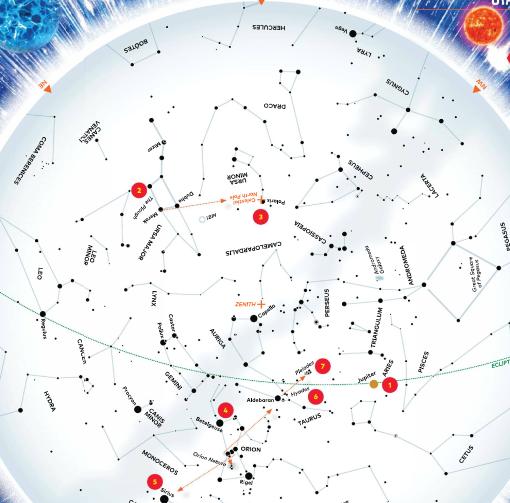Intentar ORO - Gratis
JOURNE TO THE STARS
The Week Junior Science+Nature UK
|Issue 71
Giles Sparrow reveals the night sky and its cosmic wonders.
-

For centuries, humans have mapped the night sky, weaving patterns and stories into the heavens. These star charts reveal pathways that stargazers can follow to take a voyage across space. In February, people across the UK will be doing just that, as dark sky festivals take place up and down the country. Come with us on a tour of the night sky and discover the wonders of the cosmos.
It can get very chilly at night at this time of year, so make sure you’re dressed for the cold, with a warm coat, gloves and sturdy shoes. Step outside and find an observing spot away from the glow of street lights – be sure to ask an adult to come along if you want to go beyond your front doorstep or back garden.
When you look up, try to orient yourself on the star map (right). The map shows the whole sky as it appears around 8pm in early February (or 6pm at the end of the month). To quickly find your bearings, remember that the Sun sets in the southwest. The zenith is the point directly above your head, while the horizon forms the map’s edges. The numbers on the map mark the main stops on our tour.
Don’t worry if you can’t see much at first – your ability to see faint stars improves as your eyes get used to darkness, so try to block direct light sources (if all else fails, use an umbrella). Now, you’re all set.

1 Jupiter
Esta historia es de la edición Issue 71 de The Week Junior Science+Nature UK.
Suscríbete a Magzter GOLD para acceder a miles de historias premium seleccionadas y a más de 9000 revistas y periódicos.
¿Ya eres suscriptor? Iniciar sesión
MÁS HISTORIAS DE The Week Junior Science+Nature UK

The Week Junior Science+Nature UK
FIGHTING THE FREEZE
Claire Karwowski uncovers nature's wildest ways of fighting the winter freeze.
6 mins
Christmas 2025
The Week Junior Science+Nature UK
Cook up bioplastic decorations
Make your own eco-friendly ornaments.
1 min
Christmas 2025

The Week Junior Science+Nature UK
Should we switch off Christmas lights?
They brighten up the festive season, but they can have a negative impact on the environment.
1 mins
Christmas 2025
The Week Junior Science+Nature UK
Three spectacular illuminations
Glow Wild, Wakehurst
1 min
Christmas 2025

The Week Junior Science+Nature UK
THE LAST DAYS OF POMPEII
For the first time, an immersive exhibition about the destruction of the ancient Roman city of Pompeii has opened in London.
1 min
Christmas 2025

The Week Junior Science+Nature UK
Wildlife watch
Jenny Ackland unveils a winter wonderland of natural delights this festive season.
1 mins
Christmas 2025
The Week Junior Science+Nature UK
Make Snow globes
Create the perfect Christmas gift.
1 min
Christmas 2025

The Week Junior Science+Nature UK
Maggie Aderin-Pocock
Meet the scientist \"blasting off into space\" at the Christmas Lectures.
3 mins
Christmas 2025
The Week Junior Science+Nature UK
Make vegan eggnog
Whip up a dairy-free festive winter warmer that is perfect for cold nights.
1 min
Christmas 2025

The Week Junior Science+Nature UK
Octopuses
Meet the colour-changing, shape-shifting, fortune-telling aliens of the seas.
2 mins
Christmas 2025
Listen
Translate
Change font size
